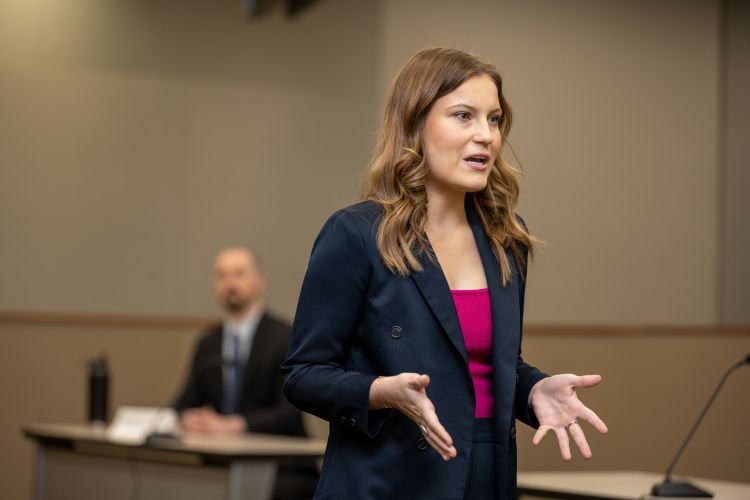Grasping the Art of Trial Presentations: Key Methods for Efficient Legal Arguments
Grasping the Art of Trial Presentations: Key Methods for Efficient Legal Arguments
Blog Article
Browsing the Complexities of Trial Presentations: Tips for Seamless Shipment and Compelling Debates
In the realm of lawful procedures, the art of test presentation stands as an essential determinant of success. The intricacies intrinsic in test presentations need a fragile balance of ability, skill, and approach.

Comprehending Test Purposes
To successfully browse a test, it is critical to have a clear understanding of the purposes that require to be attained. Prior to entering the court room, legal teams need to specify their goals and desired end results. These purposes act as guiding principles throughout the trial, shaping techniques and affecting decision-making processes.
Recognizing test purposes entails a detailed analysis of the instance, lawful criteria, and the customer's benefits. Trial Presentations. It requires a careful examination of the facts, recognizing vital problems, and preparing for possible difficulties. By establishing certain and quantifiable objectives, attorneys can tailor their debates and discussions to line up with the desired outcomes
Moreover, a clear grasp of trial purposes enables legal teams to prioritize evidence, witnesses, and lawful arguments successfully. It permits the growth of a meaningful narrative that resonates with the discretionary, enhancing the overall case discussion.

Organizing Proof Successfully
Having a clear understanding of test purposes lays the structure for organizing evidence properly in legal process. By lining up the discussion of proof with the desired results of the trial, lawful groups can reinforce their arguments and boost their persuasiveness.
One more secret aspect in arranging proof properly is establishing a sensible circulation. Offering evidence in a systematic and sequential manner can help develop a compelling story that supports the legal debates being made. Furthermore, using visual aids such as timelines, graphes, or graphs can additionally improve the organization of evidence and assist in clarifying complex connections or series of events.
Furthermore, guaranteeing that all proof provided is pertinent and permissible to the instance is essential. Unnecessary or inadmissible proof can diminish the strength of the disagreement and possibly hurt the credibility of the here and now party. Consequently, a precise review and choice process should be embarked on to consist of only the most lawfully sound and impactful evidence in the test presentation.
Crafting Influential Stories
Crafting engaging narratives plays a pivotal duty in offering influential debates throughout lawful procedures. When creating a story for a trial discussion, it is why not check here important to establish a clear story that highlights essential factors and attaches them in a meaningful way. By weaving together proof, testament, and legal debates into a convincing and cohesive narrative, legal experts can properly promote for their customers and increase the likelihood of a beneficial end result in the courtroom.
Understanding Visual Help
Reliable usage of visual aids is essential to improving the effect and quality of trial discussions. Aesthetic help, when made use of purposefully, have the power to streamline intricate information, strengthen bottom lines, and leave a long lasting impression on the court and jury. To master visual help in trial presentations, it is vital to make sure that they are clear, concise, and appropriate to the arguments being made.
When over here including aesthetic help, such as charts, photographs, timelines, or graphs, into a trial discussion, it is vital to maintain them aesthetically appealing yet expert. The visuals ought to enhance the verbal debates, supplying a graph of the information being discussed without frustrating the audience with unnecessary information.
Additionally, exercising with the aesthetic help beforehand is vital to make certain a seamless shipment during the trial. Familiarizing oneself with the material, shifts, and timings of each aesthetic aid can help preserve the circulation of the discussion and avoid technological glitches that might develop.
Supplying Impactful Closing Arguments
An engaging closing disagreement offers as the culmination of a trial discussion, encapsulating the core narrative and convincing the judge and court in the direction of a beneficial decision. Begin by laying out the main arguments that support your customer's placement, stressing why the evidence provided throughout the trial supports your narrative.
Additionally, incorporating sob story can additionally strengthen your closing debate. By humanizing the instance and linking on an individual degree with the decision-makers, you can evoke compassion and understanding, affecting their understanding of the realities offered. Furthermore, repeating the lawful requirements that should be met for a positive ruling can strengthen the legitimacy of your setting. Inevitably, a well-crafted closing argument need to leave a long lasting impression, compelling the discretionary to regulation in your client's favor.
Final Thought
Finally, grasping trial discussions entails recognizing goals, organizing evidence, crafting stories, utilizing aesthetic aids, and delivering impactful closing debates. By implementing these approaches properly, legal representatives can offer their situation seamlessly and make engaging disagreements in the court room. It is crucial to browse the complexities of trial presentations with accuracy and ability to achieve success in legal procedures.
By straightening the discussion of evidence with the preferred outcomes of the trial, lawful teams can reinforce their debates and improve their persuasiveness (Trial Presentations). To understand aesthetic aids in trial presentations, it is important to ensure that they are clear, succinct, and pertinent to the debates being made
An engaging closing debate serves as the culmination of a test discussion, encapsulating the core story and convincing the court and court in the direction of a favorable choice. Begin have a peek at this site by laying out the main arguments that support your customer's position, highlighting why the evidence presented throughout the trial sustains your narrative.In verdict, mastering test discussions involves recognizing objectives, arranging proof, crafting narratives, using aesthetic help, and delivering impactful closing disagreements.
Report this page